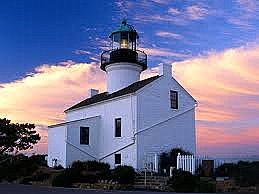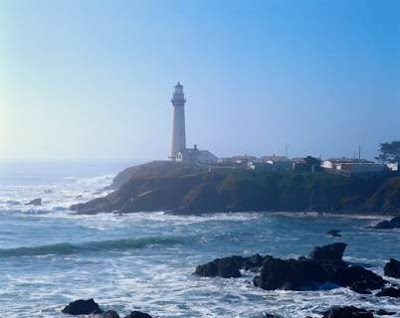They stand at the outer limits of civilization, stalwart sentinels whose distinct shapes stud all manner of seagirt rocks, treacherous ridges, wind-pummeled sandspits, and ever-eroding promontories. By day they are landmarks. By night they are beacons that puncture the darkness. But always they are silent guardians that warn of offshore rocks, shifting shoals, and perilous reefs.
They are America's lighthouses, sea-based signposts that stand where fogs cling and gales howl. Their origin dates back to 280 B. C. when the Egyptians constructed the Great Pharos of Alexandria, a 400-foot high light tower so magnificent it became one of the Seven Wonders of the World. Lighthouse history in America had its roots in Boston Harbor where, in 1716 the first New World light tower took form on Little Brewster Island--with the cost of maintaining the light paid for by taxing all merchant vessels moving in or out of the harbor a penny per ton for services rendered.
Notwithstanding the need for lighthouses on American waterways, there were but 12 to be handed over to the newly established Federal Lighthouse Service in 1789. They were not alone for long. More and more light towers began studding our coasts, rivers, and lakes and what followed was the era of the "wickies", those faithful keepers who polished brass, trimmed wicks, and kept the lamps glowing.
In 1939 the U.S. Coast Guard assumed responsibility for lighting our shores and as technology increased, more and more lighthouses were automated and every entrance locked tight. Many others were abandoned, their 19th Century heyday overshadowed by aero beacons atop 20th Century steel. A few were turned into museums, historic attractions, and privately-owned inns. Whatever their status, all remain as intriguing as the scenic places in which they stand--and all captivate the wayfarer with histories as colorful as their legion of legends.
THE BATTERY POINT LIGHTHOUSE--ENDURANCE IN EVERY EXPOSURE
 |
| Accessible only at low tide Admission fee |
It was one of the original 16 West Coast lighthouses and so sturdily constructed that even today, more than 140 years after it was built, the small stone and masonry house with its red-roofed light tower remains virtually unchanged. Quite a feat since the structure is such an easy target for Pacific storms--sitting as it does atop a tiny islet just 300 yards off the mainland of Crescent City, California.
Surrounded by the sea during high tide, and washed on three sides at low tide, the Battery Point Lighthouse has proven its endurance in every exposure, though never so well as in March of 1964 when it stood fast against a seismic tidal wave that ravaged 56 square blocks of Crescent City.
"We clung to one another," says the journal of Peggy Coons, wife of (then) keeper Roxey Coons, "and prayed that God would have mercy on us. Roxey shouted, 'let's head for the tower,' but it was too late. The wave struck, split, and swirled around both sides of the island with such speed we felt like we were sailing right along with it. Everywhere we looked was a shambles: houses, buildings, lumber, boats, all smashed or moved blocks from where they had been. It still seems hard to believe," she concluded, "that of all the salvage that floated by us, the only bit to reach the island was one spool of lavender thread."
THE BANDON LIGHTHOUSE--SURPRISES IN THE NIGHT
 |
| Though the lighthouse is in near ruins, it retains the mystique of yesteryear. One of my all-time favorite lighthouses. |
The lighthouse is empty and the tower dark. Swallows fly in and out the open door; seabirds circle overhead; incoming tides dash themselves to death on the rocks along the Coquille River's north jetty--site of the Bandon Light.
Built in 1896, the pyramidal structure served as both a seacoast and harbor sentinel, warning mariners away from what was considered to be the most dangerous bar in all Oregon--the Bandon Bar, site of more than a few tragic shipwrecks.
But even with the lighthouse in working order, there were still some surprises afloat: the C.A. Klose floundered in heavy seas; the Advance got lost in the fog. Both, albeit on separate occasions, ended up on the lighthouse doorstep. But the tales end well. No one was hurt, the schooners were repaired, and the Bandon Light went down in history as one of the few lighthouses ever hit by a ship.
THE POINT REYES LIGHTHOUSE--FACTS STRANGER THAN FICTION
 |
| Entrance is by way of Pt. Reyes National Seashore |
Beset by problems since its 1870 inception, the Point Reyes Light claims a history as riveting as any television docu-drama.: In 1872 the fog signal building burned to the ground; in 1874 an assistant keeper clambered down the cliffs to investigate a wrecked ship and was never heard from again; in 1887 the the station was reputed to be the windiest and foggiest on the West Coast (since verified by the U. S. Weather Bureau); in 1889 an assistant keeper went crazy and had to be handed over to the constable in nearly Olema; in 1916 winds in excess of 100 miles per hour took down fences, poles, chimneys, and the tank house roof. And all the time, despite the light tower, fog signals, life saving station, and radio beacons, ships continued to leave their bleaching hulls on the ragged reefs around Point Reyes. Who says facts are boring?
"In the hush of late afternoon came a shriek so piercing those who heard it froze in their tracks," says the lighthouse host as she recounts the disappearance of Muriel Trevenard. "And although the girl's friends looked for her everywhere, all they ever found was a warm pool of blood and a stained hankie. It's said that her ghost still haunts the upper chamber."
THE YAQUINA BAY LIGHTHOUSE--GHOSTLY BUSINESS
 |
| Once my granddaughter heard the ghost story, she refused to continue the tour. Gramps took her outside; I did the tour alone. Admission fee. |
A foggy day and an old lighthouse hidden behind tall trees are an unshakable combination--if you want the hairs on the back of your neck to come to attention. Never mind that the lighthouse was built in 1871 and used only three years. What's important is that after it was abandoned it fell into a state of disrepair--and everyone knows mysterious goings-on always happen in spooky old places.
Well, take heart. The lighthouse has been completely refurbished with period pieces; the banisters shine; the windows gleam. Surely no self-respecting ghost would live in such light-bright surroundings. But then again, no ghost has ever lived here. For the tale of Muriel Trevenard is pure fiction, written by Lischen M. Miller and published in 1899 by Pacific Monthly.
Turns out the lighthouse guides love to tell the ghost story. "They like to get people wondering," the Assistant Manager told me. What most of them miss is the twinkle in their eyes when whispering the tale to a group of sightseers. Twinkle? You could have fooled me. What I saw was fear.
In 1885 it was the highest elevation lighthouse in the nation. Today it is the most visited. Situated at the tip of Point Loma in San Diego, the two-story structure was not only one of the first West Coast lighthouses, but the southernmost along the edge of the (then) newly acquired California coastline.
THE OLD POINT LOMA LIGHTHOUSE--PACIFIC PATRIARCH
 |
| The Lighthouse is accessible via Cabrillo National Monument at the tip of Point Loma. Admission fee. The Monument itself is one of San Diego's best whale watching sites. |
It was a patriarch whose lamp remained lit for 36 years. There was, however, one insurmountable flaw: high fog often prevailed along this section of the coast, and although the shoreline itself was generally clear, the 462-foot high Point Loma headland was usually obscured. And so was the light. So in 1891 the old lighthouse was abandoned in favor of a new one closer to the water.
By 1913 the deserted lighthouse was so deteriorated and abused it was scheduled to be razed. "Not so," cried a citizen's group. "This San Diego landmark should be preserved." And so it was. Restored it is mid 1800s appearance, the Old Point Loma Lighthouse became a favorite tourist attraction. In 1933 it was handed over to the National Park Service as part of Cabrillo National Monument.
It still stands--a tiny lighthouse set on a hill. Useless? Maybe. But the view from the tower is still one of the most magnificent anywhere-- because on a clear day you really can see almost forever.
So treacherous were the ever-shifting sandbars at the mouth of the Columbia River that in 1853, when Congress funded the first eight West Coast Lighthouses, they gave Cape Disappointment in Washington state top priority. Here, on the river's northern edge, would stand the Pacific's first beacon of safety. But it was not to be. The bark, Oriole, loaded with men and supplies fell victim to the very ship-eating shoals they'd come to warn against, and although the men escaped with their lives, the vessel and its cargo were a total loss.
CAPE DISAPPOINTMENT LIGHTHOUSE--THE FIRST THAT FINISHED LAST
 |
| Cape Disappointment Lighthouse is in Ilwaco, WA. Entrance is through Fort Canby State Park. Admission fee. |
It was 1854 before a second load of supplies reached the Cape and another two years before the first-order Fresnel lens began casting its guardian eye seaward. The lighthouse that was to have been finished first, instead, finished last.
It still stands. And below its time-worn portals lies a century of history, for here, where waves erupt and sandbars wait, are the skeletal ribs of countless small vessels, at least 200 deep water ships, and the watery graves of 1,500 men. No wonder they wanted a lighthouse here. And no wonder this place has gained a reputation as the "graveyard of the Pacific."
America's lighthouses stand on some of the most cruelly exposed spots imaginable and, en masse, are such marvels of engineering that even now, more than a century later, we are awed by the obvious courage and ingenuity of those who risked life and limb to fashion guideposts for a trackless sea. I have featured but a few West Coast lighthouses, but there are many more scattered along every large waterway in our nation.
For more information on West Coast Lighthouses, contact the U.S. Lighthouse Society in San Francisco. For Great Lakes lighthouses, contact the Great Lakes Lighthouse Keepers Association in Allen Park, MI. For some great photos of all our nation's lighthouses, click on this link: Lighthouses By State This is a site rich in lighthouse history and even notes those lighthouses that are for sale. If you buy one, let me know. I've always wanted to stay in a lighthouse.
America's lighthouses stand on some of the most cruelly exposed spots imaginable and, en masse, are such marvels of engineering that even now, more than a century later, we are awed by the obvious courage and ingenuity of those who risked life and limb to fashion guideposts for a trackless sea. I have featured but a few West Coast lighthouses, but there are many more scattered along every large waterway in our nation.
For more information on West Coast Lighthouses, contact the U.S. Lighthouse Society in San Francisco. For Great Lakes lighthouses, contact the Great Lakes Lighthouse Keepers Association in Allen Park, MI. For some great photos of all our nation's lighthouses, click on this link: Lighthouses By State This is a site rich in lighthouse history and even notes those lighthouses that are for sale. If you buy one, let me know. I've always wanted to stay in a lighthouse.


No comments:
Post a Comment